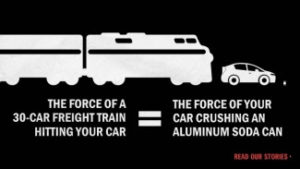The railroad is what allowed south Florida to be developed. The dream of one man, Henry Flagler, was responsible for early settlers to finally get the food and supplies needed to build communities and then cities up and down the peninsula. Today we have freight trains, Tri-Rail, Amtrak, and the new Brightline will soon be speeding along on the tracks that parallel the busy Dixie Highway corridor through Miami Dade, Broward, and Palm Beach counties.
Cars and pedestrians are natural enemies for enormous trains moving at high speeds, and while the nationwide statistics are better over time, many people are concerned that more speeding trains will bring more accidents.
Here are numbers for train accidents at crossings:
Year Collisions Deaths Injuries
1981 9,461 728 3,293
2016 2,025 265 798
 The Federal Railroad Administration provides a graphic that explains the force of a freight train hitting a passenger car is equal to a passenger car crushing a soda can.
The Federal Railroad Administration provides a graphic that explains the force of a freight train hitting a passenger car is equal to a passenger car crushing a soda can.
Many communities in south Florida have requested “quiet zones” where Brightline trains will not sound horns, and this is another concern for traffic safety experts. The fact that south Florida is home to millions of older people who may have some hearing loss is concerning.
There are many variables involved when a train hits a car at a crossing, for example, were the gates properly deployed? Was the train traveling at the proper speed? Did the train blow it’s horn? Was the car trapped on the tracks? What were the weather conditions? All these factors must be examined in order to determine if there was negligence involved.
Everyone hopes the new Brightline is a success for south Florida, and only time will tell.
Fort Lauderdale Train Accident Attorneys
If you are involved in an accident involving a train, the attorneys at Lazarus and Lazarus are experienced handling these incidents and we are available to answer your questions about what to do. Reach out to us at 954-356-0006, and thank you.




Recent Comments